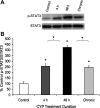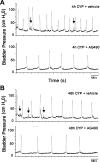Involvement of JAK-STAT signaling/function after cyclophosphamide-induced bladder inflammation in female rats
- PMID: 19625377
- PMCID: PMC2775567
- DOI: 10.1152/ajprenal.00110.2009
Involvement of JAK-STAT signaling/function after cyclophosphamide-induced bladder inflammation in female rats
Abstract
Cytokines are upregulated in a variety of inflammatory conditions and cytokine/receptor interactions can activate JAK-STAT signaling. Previous studies demonstrated upregulation of numerous cytokines in the urinary bladder following cyclophosphamide (CYP)-induced cystitis. The role of JAK-STAT signaling in urinary bladder inflammation and referred somatic sensitivity has not been addressed. The contribution of JAK-STAT signaling pathways in CYP-induced bladder hyperreflexia and referred somatic hypersensitivity was determined in CYP-treated rats using a JAK2 inhibitor, AG490. Acute (4 h; 150 mg/kg ip), intermediate (48 h; 150 mg/kg ip), or chronic (75 mg/kg ip, once every 3 days for 10 days) cystitis was induced in adult, female Wistar rats with CYP treatment. Phosphorylation status of STAT-3 was increased in urinary bladder after CYP-induced cystitis (4 h, 48 h, chronic). Blockade of JAK2 with AG490 (5-15 mg/kg ip or intravesical) significantly (P < or = 0.05) reduced bladder hyperreflexia and hind paw sensitivity in CYP-treated rats. These studies demonstrate a potential role for JAK-STAT signaling pathways in bladder hyperreflexia and referred pain induced by CYP-induced bladder inflammation.
Figures



References
-
- Anderson LC, Rao RD. Interleukin-6 and nerve growth factor levels in peripheral nerve and brainstem after trigeminal nerve injury in the rat. Arch Oral Biol 46: 633–640, 2001 - PubMed
-
- Benigni F, Fantuzzi G, Sacco S, Sironi M, Pozzi P, Dinarello CA, Sipe JD, Poli V, Cappelletti M, Paonessa G, Pennica D, Panayotatos N, Ghezzi P. Six different cytokines that share GP130 as a receptor subunit induce serum amyloid A and potentiate the induction of interleukin-6 and the activation of the hypothalamus-pituitary-adrenal axis by interleukin-1. Blood 87: 1851–1854, 1996 - PubMed
-
- Birder LA, Wolf-Johnston A, Buffington CA, Roppolo JR, de Groat WC, Kanai AJ. Altered inducible nitric oxide synthase expression and nitric oxide production in the bladder of cats with feline interstitial cystitis. J Urol 173: 625–629, 2005 - PubMed
Publication types
MeSH terms
Substances
Grants and funding
LinkOut - more resources
Full Text Sources
Miscellaneous

